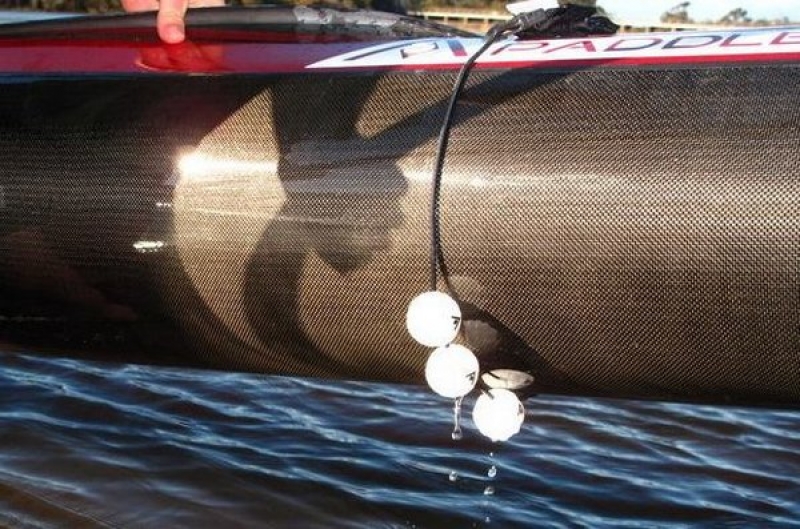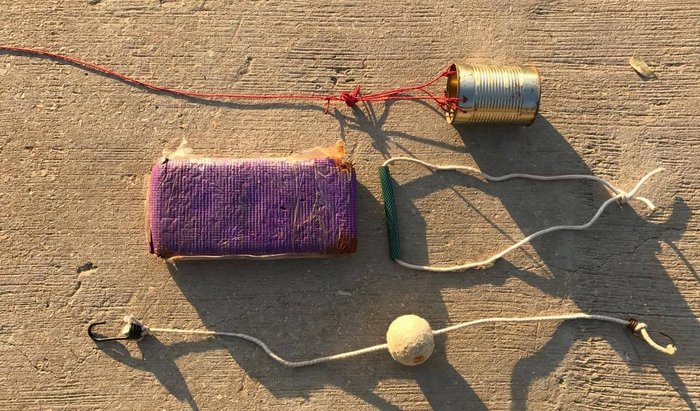Roei Yellin on Resistance Training
 Resistance training is often not practised correctly...
Resistance training is often not practised correctly...
“CAUTION – EXTRA GEEKY PADDLE POST,” read the introduction to Roei’s posts on Facebook. Roei is a geek – but he’s also been an Olympic grade paddler, a professional coach and is now sales director for Motionize, the world’s first affordable paddle tracking system. The posts caused plenty of interest so I’ve consolidated them and publish them here with Roei’s kind permission.
Mysterious Concept
One of the more mysterious concepts in paddling is resistance training. Most paddlers use resistance of some sort, but when asked why, often can't give a good answer – or just say it makes them stronger.
In this article I'll try to make things a bit clearer and less voodoo…
There are four types of popular resistances:
- Extra weight
- Bungee cord
- Ball/tube under the boat
- Tin can/parachute

Resistance Devices - take your pick!
Each one of these has a different purpose:
- Extra weight helps the paddler enhance boat glide
- The ball and tube can help the paddler improve their power of the stroke
- The tin can will help define the power phase of the stroke
- The bungee cord can improve strength and endurance
Technical
First and foremost, resistance training is a technical type of training and is not meant to improve paddler fitness. (That might be a bi-product but it’s not the prime goal.)
My goal when incorporating resistance into training (and all other technical training) is to help me improve my race stroke, meaning the ability to sustain my race DPS (distance per stroke) while maintaining my race SPM (strokes per minute).
When adding resistance to the boat, achieving my DPS becomes harder, so I must be extra careful not to lose DPS. To achieve this, I can either take my SPM lower or paddle at my race SPM, but for a shorter duration. That’s why it is extra important to monitor your DPS while doing resistance training.
How can I tell the resistance is too great or the session too hard? When I cannot achieve my race DPS, or my DPS starts to drop significantly during the session.
Warning!
Note that if you allow that to happen, your muscle memory will learn to paddle with less efficient technique - so beware! To be clear: if you overdo the resistance training and you’re not measuring your DPS (and SPM), you may actually do harm to your technique instead of improving it.
Recommendation:
Instead of going 10 minutes straight with the ball, split it.
Do:
- 10 x 40 seconds paddling/20 seconds rest or
- 1 minute paddling/1 minute rest
In other words, use resistance training for sprints/short efforts. Don’t paddle with 3 balls under the boat for an hour until you can’t keep your back straight!

(Exciting pic of a lead weight!) It can be anything - just make it 5-10% of your body weight
Weight in the Boat
Using weight is an excellent way for improving boat glide. But I'm afraid most paddlers use it in the wrong way: in an attempt to improve their force output while paddling. (Although that may be a bi-product, if you want to focus on force output, an underwater resistance like a ball or tube is more effective.)
Unique Advantage
The unique advantage of training with extra weight is the ENHANCED INERTIA of the boat while paddling. When a boat is heavier and the paddler is reaching "planing speed" he/she will feel that the boat is moving by itself; this happens because the boat has more inertia pushing the boat forward.
This state is a great condition in which to practice an efficient and short catch (meaning not paddling past vertical) because the paddler feels the boat driving itself; the only thing he should do is just nudge with a short and efficient stroke that emphasises and improves the glide.
When done correctly it feels like running downhill, with less and less effort as the boat speed increases.
Guidelines
- Use about 5%-10% of your body weight, no need for more. Remember, it’s a technical exercise; it’s not the gym!
- For maximal results, you should split the training 2/3 with the extra weight and 1/3 without. Don't forget to take the weight out, at first it will feel strange and you will have to adapt to the new stroke but that’s how your muscle memory learns to incorporate the new feeling into the technique. After 10-15 minutes you'll adjust and will have better glide and DPS.
- Use Motionize and try to see if the Stroke Length to DPS ratio has changed from your regular session. DPS minus SL is the net boat glide, try to improve it!
Resistance training to improve maximal speed and sprint.
The average DPS in a race (from 200m sprint to marathon, the only thing that varies is the SPM) is about 220-260cm.
So if we want to improve our sprint speed (first 15 seconds) we first must teach the paddler to paddle with 250cm DPS with slow SPM (stroke per minute) and slowly through the season try to increase the cadence without losing quality.
How we do that? Let’s say we have five blocks to our season. In each block we'll do two kinds of training:
- 1.50m starts x 15
- 2.50m starts with resistance (ball under the boat).
Each of these sessions we'll do on a weekly basis.
In the first block, we'll try to do all the sprints with 20 strokes each at 100 SPM. That should give us a time of about 12 seconds in each sprint.
On the resistance training I'll try to keep the same number of strokes (20) but of course at a lower cadence: 80SPM. That will result in 15 seconds for each sprint.
In the next block we'll repeat the same method but will increase the cadence for 120 SPM for the regular sprints and 100 for the resistance sprints. This way you should progress from block to block until you'll reach your expected top speed SPM.
Goal SPM
How do I know what is my expected top speed SPM? Aim for the same start SPM you had in your last major competition. In general sprint specialists start between 160-180 SPM and 1000m / marathon/ Surfski paddlers will start between 130-150 SPM.
Resistance Size
You should choose the size of your resistance according to the 250cm DPS. If you can't reach it, take a smaller resistance.
This is the template, each paddler should choose their own individual starting point and end goal for the end of the season, don't overreach; start slowly with what you know you can do and slowly but surely progress your way throughout the season
Notes
- The DPS must always be around 250cm, don't let it slip under 200cm and compensate with over extra stroking.
- Of course you can vary the distances, but make sure to keep it measurable.
- Keep it A-lactic, meaning don't overextend the sprints to more than 15 seconds.
Please share your thoughts with me,
Roei

